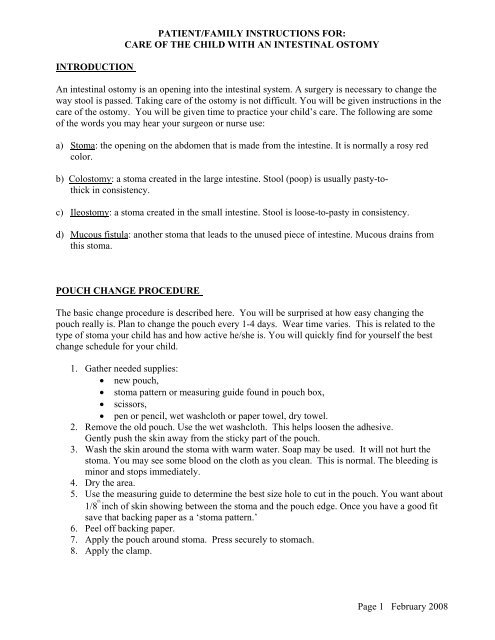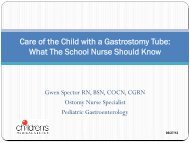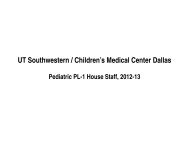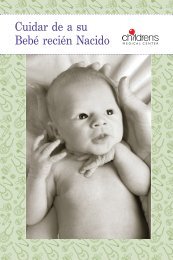Intestinal Ostomy
Intestinal Ostomy
Intestinal Ostomy
You also want an ePaper? Increase the reach of your titles
YUMPU automatically turns print PDFs into web optimized ePapers that Google loves.
INTRODUCTION<br />
PATIENT/FAMILY INSTRUCTIONS FOR:<br />
CARE OF THE CHILD WITH AN INTESTINAL OSTOMY<br />
An intestinal ostomy is an opening into the intestinal system. A surgery is necessary to change the<br />
way stool is passed. Taking care of the ostomy is not difficult. You will be given instructions in the<br />
care of the ostomy. You will be given time to practice your child’s care. The following are some<br />
of the words you may hear your surgeon or nurse use:<br />
a) Stoma: the opening on the abdomen that is made from the intestine. It is normally a rosy red<br />
color.<br />
b) Colostomy: a stoma created in the large intestine. Stool (poop) is usually pasty-tothick<br />
in consistency.<br />
c) Ileostomy: a stoma created in the small intestine. Stool is loose-to-pasty in consistency.<br />
d) Mucous fistula: another stoma that leads to the unused piece of intestine. Mucous drains from<br />
this stoma.<br />
POUCH CHANGE PROCEDURE<br />
The basic change procedure is described here. You will be surprised at how easy changing the<br />
pouch really is. Plan to change the pouch every 1-4 days. Wear time varies. This is related to the<br />
type of stoma your child has and how active he/she is. You will quickly find for yourself the best<br />
change schedule for your child.<br />
1. Gather needed supplies:<br />
• new pouch,<br />
• stoma pattern or measuring guide found in pouch box,<br />
• scissors,<br />
• pen or pencil, wet washcloth or paper towel, dry towel.<br />
2. Remove the old pouch. Use the wet washcloth. This helps loosen the adhesive.<br />
Gently push the skin away from the sticky part of the pouch.<br />
3. Wash the skin around the stoma with warm water. Soap may be used. It will not hurt the<br />
stoma. You may see some blood on the cloth as you clean. This is normal. The bleeding is<br />
minor and stops immediately.<br />
4. Dry the area.<br />
5. Use the measuring guide to determine the best size hole to cut in the pouch. You want about<br />
1/8 th<br />
inch of skin showing between the stoma and the pouch edge. Once you have a good fit<br />
save that backing paper as a ‘stoma pattern.’<br />
6. Peel off backing paper.<br />
7. Apply the pouch around stoma. Press securely to stomach.<br />
8. Apply the clamp.<br />
Page 1 February 2008
POUCH EMPTYING PROCEDURE<br />
1. Supplies needed:<br />
• small basin or soiled diaper,<br />
• irrigation bottle or syringe,<br />
• soap and water,<br />
• toilet paper.<br />
2. Hold end of pouch up and open clamp.<br />
3. Drain stool into small basin or soiled diaper. Older children will drain their pouch directly<br />
into the toilet.<br />
4. Flush pouch with soapy water. See comments below on flushing.<br />
5. Clean end of pouch with toilet paper and close clamp.<br />
6. Dispose of basin contents/diaper.<br />
• Regular attention to the ostomy prevents leaks and frequent pouch changes.<br />
• Empty the pouch when it is about 1/3 full.<br />
• Let out excessive gas as needed even if it is not necessary to empty the pouch<br />
• Mix soap and water solution to use in flushing pouch. 1-2 drops dish soap in a quart of tap<br />
water.<br />
• Flush as desired but be careful to not pull pouch loose.<br />
SKIN CARE<br />
This is the most important part of caring for the stoma. Frequent pouch changes and frequent<br />
leakage can irritate the skin around the stoma. To decrease skin problems:<br />
• Always change the pouch promptly when leaking.<br />
• Ask your nurse for help if leakage is on-going<br />
• Be careful to cut pouch opening the same size as the stoma. Large openings lead to skin<br />
irritation.<br />
BATHING<br />
Your child may bathe (tub or shower) with the pouch on or off. Soap and water will not harm the<br />
stoma. A good washing and airing may be helpful for the skin around the stoma. Your child may<br />
use any bath soap except those containing oils. Rinse area with clear water prior to reapplying the<br />
pouch.<br />
CLOTHING<br />
Your child may wear whatever clothes they like with their ostomy.<br />
• Infants and toddlers benefit from a one-piece garment. This age group often pulls their<br />
pouches off and a one-piece garment helps prevent pulling on the pouch.<br />
• The pouch may be inside or outside the diaper or underwear, whatever seems most<br />
comfortable.<br />
• If the stoma is near your child’s waistline it is important that tight belts or pants not cause<br />
pressure on the stoma.<br />
Page 2 February 2008
DIET<br />
• Your child should eat a diet normal for his/her age. No special precautions are required<br />
because of ostomy surgery.<br />
• It is recommended that your child eat a well-balanced diet of meats, fruits and vegetables.<br />
• However, some foods may cause excessive gas and odor.<br />
• These lists are provided for your information in reducing problems with gas and odor. Do<br />
not routinely exclude these foods from your child’s diet.<br />
apple skins - meats with casings<br />
(sausage, hot dogs)<br />
celery - mushrooms<br />
Chinese vegetables - nuts<br />
coconut - orange rinds<br />
beans - broccoli<br />
carbonated beverages - cabbage<br />
cucumbers – brussel sprouts<br />
asparagus-broccoli<br />
cheese – brussel sprouts<br />
eggs - cabbage<br />
Hard to Chew/Digest Foods<br />
Gas-causing Foods<br />
Odor-causing Foods<br />
coleslaw - popcorn<br />
corn - potato skins<br />
dried fruit - raisins<br />
grapefruit - seeds<br />
dairy products - cauliflower<br />
mushrooms - onions<br />
fish - cauliflower<br />
some spices - onions<br />
ACTIVITIES<br />
Your child will quickly resume their usual activities. As a parent you will worry about allowed<br />
activities. Aside from general home safety precautions, any activity is okay. Children doing<br />
sports may need special protection for their stoma. Discuss this with your nurse or surgeon.<br />
Below are some special considerations:<br />
.<br />
1. Child Care.<br />
Arrange a meeting with the day care staff to discuss the ostomy and to instruct the staff in<br />
care for the ostomy,. Make sure the day care providers have extra ostomy supplies available<br />
2. School Issues.<br />
Inform school staff about your child’s ostomy. Important persons to talk with are your<br />
child’s homeroom teacher, gym teacher, school nurse, and the school principal.<br />
Make arrangements for your child to use the bathroom whenever necessary. Your child will<br />
need extra time or more privacy. Regular bathroom breaks are usually not sufficient,<br />
Keep extra supplies with the school nurse. Older children may keep an emergency kit in<br />
their backpack.<br />
Page 3 February 2008
3. Traveling.<br />
An ostomy does not require special precautions or adaptations for a car seat or booster seat.<br />
Seat belts can be worn by anyone with an ostomy. Always carry the ostomy supplies with<br />
you, in case your luggage is lost. Keep ostomy supplies in the main compartment of the car<br />
or van. Heat and cold can damage supplies. Pack twice as many supplies as you should<br />
need. Carry a reference card with the ostomy supplies. order numbers, brand in the event<br />
you need to purchase something while out of town.<br />
ACCESSORY SUPPLIES<br />
Occasionally children need extra supplies to assist the pouch to remain leak proof or to prevent<br />
skin irritation. Following is a list of some these supplies. Please note your child may or may not<br />
need any of these supplies.<br />
Stomahesive Paste: A paste used to fill in irregular areas on the skin. This is commonly called<br />
caulking for ostomies. This product comes in a tube. It has a small amount of alcohol in it so it may<br />
cause temporary burning on irritated skin. Never use the paste with a urostomy or stoma with large<br />
amounts of liquid output.<br />
Eakin Cohesive Seals: Moldable rings that are helpful when paste cannot be used or when paste<br />
does not work.<br />
Protective Barrier Wipe: A small pad in a foil packet that is applied to dry skin and allowed to dry.<br />
The pad leaves an invisible protective barrier on the skin.<br />
Adhesive Remover Pad: A small pad in a foil packet that is used to loosen the adhesive. It can make<br />
removing ostomy pouches easier. Any adhesive remover leaves an oily film on the skin that must be<br />
washed away before the next pouch is applied.<br />
Stomahesive Powder: A powder designed to be used around ostomies. The powder will heal irritated<br />
skin, but must be ‘sealed’ in place with a protective barrier.<br />
WHO TO CALL<br />
For problems with the surgery site or the stoma, call your surgeon:<br />
Name_______________________ Telephone Number ______________________<br />
For skin care problems and general questions about care, call the Advanced Practice Nurse:<br />
Name _______________________ Telephone Number _______________________<br />
For well baby checks, immunizations, and illnesses, contact your pediatrician or clinic.<br />
Page 4 February 2008
HOME SUPPLIES<br />
Supplies for home use has been arranged through the following company. Please contact<br />
this company for supplies after discharge.<br />
Company Name ____________________________________________________________<br />
Telephone Number _____________________ Contact Person _______________________<br />
Page 5 February 2008








